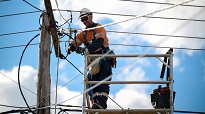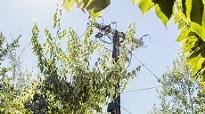We inspect network assets to make sure they are in a serviceable and safe condition. Obstructions or defects on our assets are a safety hazard and can stop our crews from being able to restore power outages.
If we find a problem on network assets on your property, we will issue a Network Protection Notice which requires you to rectify the problem within the given timeframe.
We’re here to help you ensure your property and our network are safe – so if you have any questions about the notice or are unsure how to rectify it, please get in touch. In some circumstances where we become aware of safety hazards, we have a responsibility and legal right to disconnect the electricity supply.
Before building or landscaping on your property, you should always check the placement of utility assets and be aware of the minimum clearances.
Network Protection Notices
- If you have rectified an obstruction or defect in a Network Protection Notice, let us know below.
- If you have arranged a licensed contractor to rectify the obstruction or defect in the Network Protection Notice, and the booking is past our required timeframe, apply for an extension below.
- If you are a tenant of a rental property, pass the notice onto your rental manager or property owner.
Only licensed and qualified contractors can work on or near our network. For your safety, you will need to engage a licensed person to rectify a network obstruction or defect.
Examples of obstructions and defects
-
Defect
A defect includes unapproved fixtures on electricity assets such as basketball hoops, flood lights, awning fixtures, and security cameras that have been fixed to power poles. This also includes unapproved network connections. For example, pools that have been built underneath powerlines.
-
Obstruction
An obstruction includes structures, materials or equipment that are not a safe minimum distance away from electricity assets. They may also prevent our crews from being able to access the asset. Garden sheds, compost heaps, pergolas or chicken pens are examples of obstructions.
If there is a hard surface too close to network assets, you will be required to temporarily remove it for routine inspections. Masonry pavers are a recommended hard surface as they can easily be removed.
-
Point of attachment (POA)
The point of attachment (POA) is the point where overhead powerlines connect to your property. The POA determines the point at which there is a cross over from the Evoenergy electricity network to your own internal electrical works.
We can legally only undertake works on assets considered part of our energy network. This means damage to anything past our network boundary, must be undertaken by a private electrical contractor.
If you do call Evoenergy to take a look at your damaged POA, our crews will ensure safety of the distribution network, however we cannot replace or repair any equipment on which is part of your home’s internal electrical works.
Example A
This is an approved service connection, clear of defects and compliant with the Service and Installation Rules. Underground services can be useful when rectifying obstructions.
Example B
The overhead service from the pole to the point of attachment at the customer house is obstructed by a pergola or car port. This requires either removal of the obstruction, service relocation, or conversion to an underground service.
Example C
There is a hazardous tree posing an impact risk to electrical infrastructure. The tree requires trimming or removal.
A garden bed planted around the power pole creates an obstruction and requires removal.
A 1.5m clearance around Evoenergy assets is generally required. Refer to our website for more information: www.evoenergy.com.au/safety/building-near-utility-assets
Example D
The homeowner has built a path over the underground service cable and has planted a garden bed around the minipillar, obstructing access.
A 1.5m clearance around Evoenergy assets is generally required. Refer to our website for more information: www.evoenergy.com.au/safety/building-near-utility-assets
Example E
The overhead service has insufficient clearance from the shed in back corner of the yard. Rectifying this may require removing the shed, relocating the service, or converting the service to underground.
A 1.5m clearance around Evoenergy assets is generally required. Refer to our website for more information: www.evoenergy.com.au/safety/building-near-utility-assets
Example F
The overhead service goes over a pool and should have been changed to an underground service if appropriate building applications were submitted. This can be resolved by relocating the point of attachment or undergrounding the service.
Clearances are outlined in AS 3000 Clause, 6.3 and Utilities Networks (Public Safety) Regulation 2001 Clause 26, both available at www.legislation.act.gov.au.
Example G
The overhead service from the pole to the point of attachment at the customer house is obstructed by a pergola or car port. This requires either removal of the obstruction, service relocation, or conversion to an underground service.
Example H - I
Attachments like basketball hoops, floodlights, awning fixtures, and security cameras on Evoenergy’s infrastructure are prohibited. Keep all private assets clear from power poles and other energy assets.
Private power poles and assets
Private power poles can be identified by looking for a yellow Private Pole tag or a number starting with ‘P’. If there is a private power pole on your property, you are responsible for its maintenance and safety as the owner of it.
We offer fee-for-service line inspection, testing and maintenance services for private powerlines and poles. While we are not responsible for testing or maintaining private assets, if we become aware of a problem with a private pole or asset while inspecting Evoenergy-owned assets, we will notify you.
Maintaining private power poles involves regularly inspecting and maintaining them with qualified electricians. The base of the poles should be kept clear of vegetation and clutter, and trees should be kept clear of powerlines. It’s important to check for line defects such as broken cross arms, leaning poles, missing nuts and bolts, wires too close to the ground, loose or damaged insulators, and broken or damaged pole stay-wires.
We also recommend you check insurance coverage for pole replacement or damage caused by defective private powerlines or poles. For more information read our private powerlines and poles factsheet or contact us on 13 23 86.





